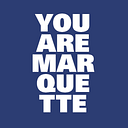
The costs of crossover
Dr. Cedric Burrows is recognized with a top award for his book that argues mainstream culture welcomes Black contributions while placing strict limits on how they’re expressed.
Reported by Lora Strum and Stephen Filmanowicz
As Black people have become more visible in white culture with growing influence on the arts, entertainment, fashion and more, Dr. Cedric Burrows’ scholarship has become interested in the concept of crossover. In the music world, it’s the phenomenon of a song or an artist moving beyond an original genre and audience into broader relevance — Taylor Swift trading country music for pop stardom, or Beyoncé becoming a pop culture icon after a start in rhythm and blues, and soul.

As an associate professor of English, Burrows is interested in the rhetorical dimensions of this process. His book, Rhetorical Crosssover: The Black Presence in White Culture, explores the movement of the Black rhetorical presence in mainstream spaces both historically and currently. In it, Burrows observes that mainstream culture “has always constructed coded narratives on how the black rhetorical presence should appear and behave when in majority spaces,” with negative consequences for expressions that stray outside mainstream expectations.
Burrows is being hailed for making a major contribution to rhetorical scholarship with this book. The National Council of Teachers of English recognized Rhetorical Crossover with its highest honor for scholarship, the 2021 David H. Russell Distinguished Research Award.
“Burrows’ dynamic book shows us exactly where African American rhetoric has always already been and makes the reader feel the cultural impact of blackness that can’t be denied,” states colleague Gwendolyn Pough, Dean’s Professor of the Humanities in women’s and gender studies at Syracuse University, in announcing the award.
“Burrows’ dynamic book shows us exactly where African American rhetoric has always already been and makes the reader feel the cultural impact of blackness that can’t be denied.”
In the book, Burrows argues that when Black rhetoric moves into the dominant culture, “white audiences appear welcoming to African Americans as long as they present an acceptable form of blackness for white tastes.”
These acceptable narratives affect everything society does, including how it fights for racial justice, Burrows argues. He references a video he found on social media shortly after a white supremacist drove a car into a group of anti-racist protesters in Charlottesville, Virginia. In the post, a Black man engages in a physical altercation with a known white Klansman. The posted comments denounced the Black man’s emotions, calling him violent and a detriment to racial justice efforts. The idea that a Black person must express anger peacefully is codified into America’s acceptance of Blackness, Burrows says. It happened again the summer of 2020 when members of the media criticized Black Lives Matter activists for perceived acts of violence during protests.
“When Black people express natural emotions, it is often considered threatening,” Burrows says. “What is missing when judging the emotions are the events that led up to the response.”
“When Black people express natural emotions, it is often considered threatening,” Burrows says. “What is missing when judging the emotions are the events that led up to the response.”
Outside this mainstream lens, African Americans have developed their own narratives that revise and reinvent mainstream narratives while also reaffirming their humanity, Burrows says. Rhetorical Crossover details the “dueling narratives” about African Americans that percolate through music, education, film and social movements in the United States.
As Pough concludes, “Burrows takes the personal and shows us how it is political, rhetorical and culturally relevant. Communities inside and outside of academia can and should learn something from this important contribution.”


